Tatbir


Tatbir (Arabic: تطبير), also known as Talwar zani and Qama Zani in Iran and South Asia,[1] is an act of mourning by a large group of Shia Muslims (it is forbidden according to some Grand Ayatollahs but not forbidden according to most of Grand Ayatollahs) for the younger grandson of Muhammad, Husayn ibn Ali, who was killed along with his children, companions and near relatives at the Battle of Karbala by the Umayyad Caliph Yazid I. Tatbir is a contested issue among Shia. Most clerics deem it to be self-harm and hence Haram. However, a small minority of Shia do perpetuate the practice in defiance.
Performance of Tatbir
Tatbir is practiced by some Shia Muslims on the 10 Muharram of the Islamic calendar, known as "the Day of Ashura", and on the 40th day after Ashura, Known as "Arba'een/Chehelom" by Twelvers around the world. Some Shia may also perform tatbir on other occasions as well.
The practice of Tatbir includes striking oneself with a form of a talwar "sword" on the head, causing blood to flow in remembrance of the innocent blood of Imam Husayn. Some Twelvers also hit their back and/or chest with blades attached to chains.
Views of Grand Ayatollahs regarding Tatbir
Tatbir is contested among Shia clerics, while some traditionalist clerics allow believers to indulge in tatbir, modernist clerics deem it impermissible because it is considered self-harm thus Haram in Islam.[2] Most religious authorities associate all forms of self-flagellation and blood-letting as ways to relate to painful deaths during battle of Karbala by Imam Husayn and supporters.[3]
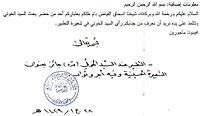
| # | Image | Grand Ayatollahs | Views | Description |
|---|---|---|---|---|
| 1 | 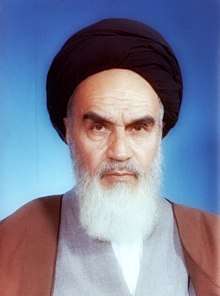 |
Ruhollah Khomeini | Prohibited | “You want to do something for God, but in situations where your actions might harm Islam, refraining is best. Instead participate in chest beating processions endeavour to hold these events with greater glory.”[4] |
| 2 | .jpg) |
Abu al-Qasim al-Khoei | Not Forbidden | Many Grand Ayatollahs state that Ayatollah Khoei allowed tatbir like: Mirza Jawad Tabrezi [5], Ayatollah Bahjet[6], Safi Golpaygani[7], Muhammad Shahroudi [8], Mofti al-Shia [9], Sadiq Hussain Shirazi [10] and Taqi Tabatabei Qomi[11].In a question asked about tatbir he replied:"There is no problem in performing such act"[12] |
| 3 |  |
Mohammad Ali Araki | Not Forbidden | "If there is no danger of dying from this act, then it is permissible (allowed)".[13] |
| 4 | 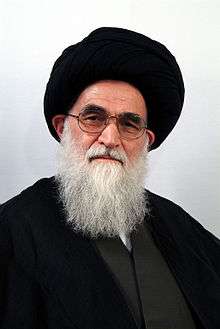 |
Sayyid Sadeq Rohani | Not Forbidden | He said: "I love the youths that do tatbir /Qama Zani and I ask Allah to resurrect me with them." |
| 5 | 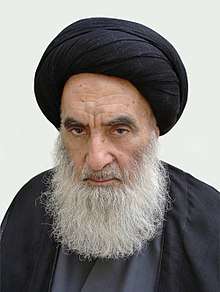 |
Ali Sistani | Abstained from answering | Refer to another Marja for guidance on this issue [14] |
| 6 | 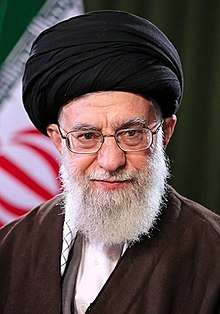 |
Ali Khamenei | Forbidden | Ali Khamenei, Supreme Leader of Iran has stated that Tatbir is forbidden. [15] |
| 7 |  |
Sadiq Hussaini Shirazi | Not Forbidden | According to Shirazi, the ritual of Tatbir (Qama Zani) is Halal and Mustahab.[16] Shirazi deems tatbir permissible for women as according to him, tatbir was first practiced by Lady Zainab, a woman.[17] |
| 8 | 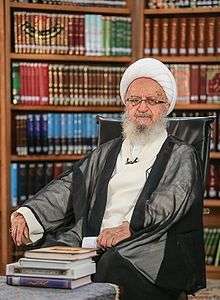 |
Naser Makarem Shirazi | Forbidden | Muslims should avoid actions that display weakness in the Shia religion and damage the body.[14] |
| 9 | .jpg) |
Mohammad Fazel Lankarani | Forbidden | Tatbir shows the harsh face of mourning of Husayn ibn Ali and it harms Shiism.[14][18] |
| 10 |  |
Abdollah Javadi-Amoli | Forbidden | It is not permissible to insult Islam and the desecration of mourning. Therefore, it is better to avoid Tatbir and things like that.[14] |
| 11 |  |
Mohammad-Taqi Bahjat Foumani | Forbidden | It should be avoided; every act that would be an insult to the Shia.[14] |
| 12 |  |
Hossein Noori Hamedani | Forbidden | Should be avoided as actions that weakens the Shia religious.[14][18] |
| 13 | 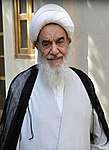 |
Hossein Mazaheri | Forbidden | When Wali e Faqih (Guardian Jurist) orders to avoid something, all people have to avoid it, even if they do not follow Guardian Jurist.[14] |
| 14 | 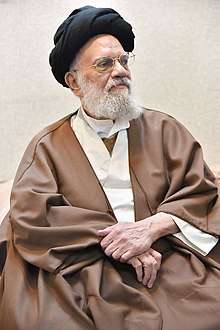 |
Kazem al-Haeri | Forbidden | Tatbir is a superstition that causes the defamation of Islam and Shia Islam in particular.[14] |
| 15 | 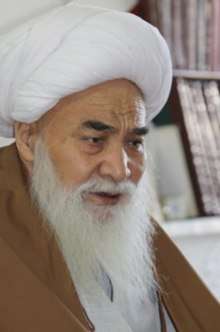 |
Mohaqiq Kabuli | Forbidden | There is no allowance to practice Tatbir or self-flagellation or something else that is considered as self-harm. |
| 16 | 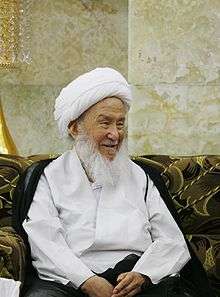 |
Muhammad al-Fayadh | Not Forbidden | Tatbir is permissible, if it does not cause serious damage to the body.[19] |
| 17 | Muhammad Saeed al-Hakim | Not Forbidden | Tatbir as one form of the mourning of Husayn ibn Ali is permissible. It is permitted under the intention of sympathy with God and trust-seeking, to promote searching for trust. | |
| 18 | .jpg) |
Hossein Vahid Khorasani | Not Forbidden | "Shame to those people who wish to erase these Hussaini rituals.Beware people of Iran..know the smallest word spoken against the Hussaini sha’air breaks the back of the seal of the Holy Prophets (p). These azadari rituals - chest beating, beating with chains - have the highest need of being protected."Whose words are these? 'Mercy be on those loud cries (sarkhaat) made for our sake'..those unwise peaople are incorrcet when they say don’t raise voice when crying.this is our 6th imam the head of our school of thought this hadees was his hadees so who is this jurist (to disregard this statement?) Those jurists whose era has ended the jurist naeni, jurist barojurdi, the jurist haeri, these were jurists and they said beat your chests, hit yourself with chains, and if you shed blood, then shed it."[20] |
| 19 | 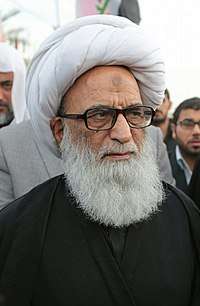 |
Bashir al-Najafi | Not Forbidden | "Tatbir is permitted until it describes sorrow for Imam Hussain".[21] |
| 20 | 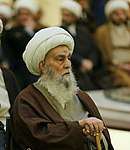 |
Shamsodin Vaezi | Not Forbidden | "Tatbir is permissible (allowed) and the issue is described in detail in our book Al-Husseini rituals".[22] |
| 21 |  |
Lotfollah Safi Golpaygani | Not Forbidden | The Grand Ayatollah Sheikh Safi Gulpaygani described the Husseini rituals as a link between all Shiites around the world, including the self-flagellation rituals(Qama Zani or Zanjeer Zani).[23] |
| 22 | 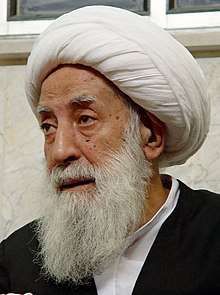 |
Jawad Tabrizi | Not Forbidden | "Tatbir is permissible (allowed) and it is a Mustahab act, this is due to some narrations which state that: When sayyida Zainab saw Imam Hussain's head, she smashed her head into a rock and blood flowed from her head"[24] |
Criticisms
- Tatbir is a mourning ceremony that calls for self-flagellation and consequent blood shedding. At the ceremony, mourners strike themselves with daggers/blades on their head and other parts of their body. It is considered unsanitary as blood introduced into environment through open wounds of mourners can carry dangerous diseases, such as, Hepatitis B (HBV), Human Immunodeficiency Virus (HIV), Hepatitis C (HCV), Syphilis, Malaria, Brucellosis, Babesiosis, Leptospirosis, Arborviral Infections, Relapsing fever, Creutzfeldt–Jakob disease (Mad Cow disease), and Viral hemorrhagic fever (Ebola virus).
- Tatbir can also cause disturbances in the mental balance of people of society gathering to view it.[25][26]
- There are different opinion about the practice of Tatbir. Shia believes that it is a form of self-harm, so it must be forbidden. Others who practice Tatbir consider it as "folk practice". According to some sects of Shia, it is felt Tatbir reflects on Shia observers poorly, so they typically avoid it in a region where Sunnies also reside. Abbas Shams al-Din, a Shia cleric, said: "these practices used to be limited and no one paid attention to them, but they have started to spread and defame the image of the event in a huge way." [27]
- Iraqi sociologist Ibrahim al-Haidari has called Tatbir an irrational act. He states blood donations should replace Tatbir. Hussein Al-Sadr, Iraqi cleric and his followers donate blood every year during the mourning of Husayn ibn Ali. [28]
- Hassan Nasrallah, the leader of Hezbollah in Lebanon, has also taken steps to end Tatbir. Instead of practicing Tatbir, he offered to donate blood on Ashura day to patients who need it.[27]
- Mohammad Mehdi Shamseddine established a Blood bank in Najaf to donate blood on Ashura day to patients who need it.[29]
References
- ↑ "Fatwa on Tatbir [Qama Zani]". Pasbaan-e-Aza. Archived from the original on September 10, 2009. Retrieved 2010-07-03.
- ↑ Monsutti, Alessandro; Naef, Silvia; Sabahi, Farian (2007). The Other Shiites: From the Mediterranean to Central Asia. Peter Lang. pp. 146–. ISBN 978-3-03911-289-0. Retrieved 2015-09-30.
- ↑ Tabbaa, Yasser; Mervin, Sabrina (28 July 2014). Najaf, the Gate of wisdom. UNESCO. pp. 154–. ISBN 978-92-3-100028-7.
- ↑ http://tatbir.org/?page_id=98
- ↑
- ↑
- ↑
- ↑
- ↑
- ↑
- ↑
- ↑
- ↑ Ayatollah Muhammad Ali Araki's Fatwa
- 1 2 3 4 5 6 7 8 "opinions of the Maraj'e in regard to using Qama". Retrieved 19 October 2015.
- ↑ http://english.khamenei.ir/news/4209/Tatbir-is-a-wrongful-and-fabricated-tradition-Imam-Khamenei
- ↑ "Bloodletting-Tatbir". shirazi.ir. Retrieved 30 November 2014.
Question: Doing matam with Qama or Chain Leads is Halal or Haram? Answer: As for the ritual of Tatbir (Qama Zani) it is Halal and Mustahab.
- ↑ Shirazi, Sayyid Sadiq Husayni. Islamic Law: Books One and Two Volume 2 of Acts of worship & CULTURE, ECONOMICS, ETHICS. Fountain Books. p. 616. ISBN 1903323401. Retrieved 30 November 2014.
- 1 2 "What are the opinions of the Maraj'e in regard to using Qama in the past and in present time?". Retrieved 19 October 2015.
- ↑ "Grand Ayatollah Mohammad Ishaq al-Fayyad response to Tatbir". Retrieved 26 October 2015.
- ↑ http://www.jafariyanews.com/2k9_news/dec/21Vahid_Khorasani_azadari_verdict.htm
- ↑ Fatwa's of maraji on tatbir
- ↑ Grand Ayatollah Shamsodin Vaezi on Tatbir
- ↑
- ↑ Official website]
- ↑ "Tatbir". Tatbir.org. Retrieved 2016-01-05.
- ↑ Masaeli, Mahdi. "Tatbir" (PDF). Fetan. Golban Publication.
- 1 2 HUBBARD, BEN. "Bloody and Belittled Shiite Ritual Draws Historic Parallels". The New York Times Company. Retrieved November 2014. Check date values in:
|accessdate=(help) - ↑ Mamouri, Ali. "Iraqi Shiite pilgrimage takes political turn". Al-Monitor. Retrieved December 2014. Check date values in:
|accessdate=(help) - ↑ "Mohammad Mehdi Shamseddine(in Persian)". nbo.ir.